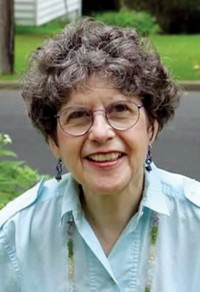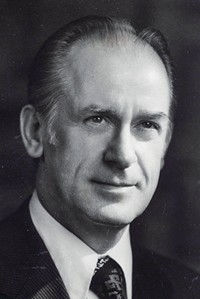Advertisement
Grab your lab coat. Let's get started
Welcome!
Welcome!
Create an account below to get 6 C&EN articles per month, receive newsletters and more - all free.
It seems this is your first time logging in online. Please enter the following information to continue.
As an ACS member you automatically get access to this site. All we need is few more details to create your reading experience.
Not you? Sign in with a different account.
Not you? Sign in with a different account.
ERROR 1
ERROR 1
ERROR 2
ERROR 2
ERROR 2
ERROR 2
ERROR 2
Password and Confirm password must match.
If you have an ACS member number, please enter it here so we can link this account to your membership. (optional)
ERROR 2
ACS values your privacy. By submitting your information, you are gaining access to C&EN and subscribing to our weekly newsletter. We use the information you provide to make your reading experience better, and we will never sell your data to third party members.
People
Obituaries
by Rachel Petkewich
April 3, 2006
| A version of this story appeared in
Volume 84, Issue 14
Charles E. Aiman, 70, an industrial chemist, died unexpectedly on March 16.
Born in Kansas, he graduated with a B.A. in chemistry and was the valedictorian of his class at Park College in Kansas City, Mo. In 1962, he completed a Ph.D. in organic chemistry at the University of Kansas.
He began his career with Aldrich Chemical in Milwaukee and subsequently worked at Lakeside Labs, Merrell-National Laboratories, and Merrell Dow Pharmaceuticals. Aiman then moved his family to Michigan for a job with Dow Chemical.
After retiring from Dow, he joined Hoechst Marion Roussel, Hoechst, and Aventis; he recently retired from Sanofi-Aventis. He consulted on pharmaceutical technology matters in intellectual property disputes.
Aiman coached soccer and baseball, led scout troops, and is remembered as a marvelous storyteller. He is survived by his wife, Loretta; three sons; and two grandchildren.
Henry E. Baumgarten, 85, an organic chemistry professor retired from the University of Nebraska, died on March 12.
Hailing from Texas, he earned a B.A. in 1943 and an M.A. in 1944, both in chemistry, from Rice University. After service with the Navy in the Pacific during 1944 and 1945, he returned to Rice and completed his Ph.D. in chemistry in 1948.
He began his career as a research associate at the University of Illinois with Carl (Speed) Marvel. Baumgarten moved to the University of Nebraska in 1949. During his nearly 40-year tenure there, he served as a professor, chair of the chemistry department, president of the academic senate, and vice chancellor for research.
Baumgarten researched the structure and reactivity of organic molecules. He focused on amines and strained rings, including pioneering efforts on α-lactams, and fostered an early appreciation for the potential of nuclear magnetic resonance and mass spectrometry in organic chemistry. In 1962, he received a Guggenheim Fellowship.
He was an editorial board member for the Journal of Organic Chemistry. Baumgarten was also on the board of directors and the editor of the fifth collective volume of Organic Syntheses. With Walter Linstromberg, he coauthored five editions of an organic chemistry lab manual that are well-known to both college students and instructors.
An emeritus member, he joined ACS in 1946. He was also secretary of the ACS Nebraska Section in 1953, chair in 1956, and alternate councilor from 1966 through 1968.
As a birder, Baumgarten served as both an author and assistant editor for the Nebraska Bird Review. He was a member of and an officer in both the Audubon Naturalists' Club and the Nebraska Ornithologists' Union. After his retirement, he became active in the Nebraska Academy of Sciences.
He is survived by his wife, Dorothy, and four children.
Thomas C. Hofelich, 52, who specialized in calorimetric analysis applied to industrial chemical problems, died of cancer on March 11.
Hofelich received a B.S. in chemistry from Clarkson University in Potsdam, N.Y., in 1975. Five years later, he completed a Ph.D. in physical organic chemistry at the State University of New York, Buffalo.
After two years as a postdoctoral fellow at Duke University, he joined Dow Chemical in 1982. He spent one year in the chemical processes lab, then transferred to the thermal analysis group in the company's analytical lab, where he would spend the rest of his career.
He won numerous awards for his work with reactive systems, including development and commercialization of the Two-Drop Calorimeter. Hofelich also developed in situ thermal processes for analysis and applied thermoanalytical techniques to runaway reaction hazards. His recent work included high-throughput calorimetry, microcalorimetry, and product lifetime prediction.
An avid golfer, Hofelich also enjoyed haiku and cooking, and he was an accomplished and versatile musician. He volunteered in his community for a youth jazz group, a local zoning board, and the organizing board of the Currie Golf Course Players Association.
He is survived by his wife, golf partner, and colleague, Marabeth; two children; two stepchildren; both parents; and four siblings. He joined ACS in 1977.
Thomas W. McGee, 74, a Dow career chemist, died on March 7.
Born in Chariton, Iowa, he received degrees from Creighton University in Nebraska and a Ph.D. in organic chemistry from the University of Iowa, Iowa City. He served in the military with the U.S. Army Corps of Engineers and the Field Artillery. He retired in 1994 after a 34-year career at Dow Chemical.
McGee is survived by his wife, Peggy; five children; and nine grandchildren.
Ira A. Murphy, 88, a latex researcher at Dow, died on March 8.
Born in Michigan, he attended Heaney's Commerical College from 1936 to 1938 and then worked at Certain-Teed Products until he was inducted into the Army in 1942. He served with the 654th Engineer Topographic Batallion. After he was discharged from the Army in 1945, he returned to Certain-Teed.
Murphy graduated with a B.S. in chemistry from the University of Michigan in 1953. He completed a Ph.D. in organic chemistry in 1957 and spent 25 years working for Dow Chemical. First, he worked in research, mainly on latex paint. Then he moved to the company's patent office, where he filed patents for latex in the U.S., Europe, and Asia.
Murphy was a deacon in his church and helped senior citizens prepare their taxes. He loved square dancing. Other interests included golfing, tennis, playing cards, camping, hiking, attending concerts, and traveling.
He was preceded in death by his first wife, Dora, and is survived by his wife, Hattie Schmidt Kloha; seven children; 21 grandchildren; 32 great-grandchildren; one great-great grandchild; and four siblings.
Louis M. Trefonas, 74, who is best known for studying the structures of cancer-causing chemicals, died on March 2 after a prolonged illness.
Trefonas earned an M.S. in chemistry in 1954 at the University of Chicago and a Ph.D. in chemistry in 1959 from the University of Minnesota. His adviser was Nobel Laureate William N. Lipscomb.
For more than two decades, Trefonas studied crystal and molecular structures as a professor in the chemistry department at the University of New Orleans. He also served as department chair. Later, he was vice president of research and graduate dean at the University of Central Florida, Orlando. He retired in 1999. He also served as chair of the ACS Orlando Section in 1994.
Trefonas is survived by his wife of 48 years, Gail; six children; and eight grandchildren. He joined ACS in 1978.




Join the conversation
Contact the reporter
Submit a Letter to the Editor for publication
Engage with us on Twitter